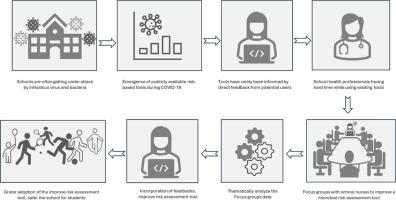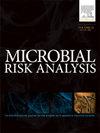根据学校卫生人员的直接反馈,改进微生物风险评估工具
IF 4
4区 环境科学与生态学
Q2 ENVIRONMENTAL SCIENCES
引用次数: 0
摘要
由于COVID-19的影响,公开的基于风险的工具越来越受欢迎。然而,学科专家在开发这些工具时没有咨询最终用户。因此,本研究旨在通过焦点小组探讨用户对微生物风险评估工具开发的看法、愿景和指导。该工具旨在协助学校卫生工作人员就学校呼吸道病毒暴发作出决策。我们与图森市区的一个学区合作,与学校卫生工作人员进行了三个焦点小组讨论,以收集对风险工具原型的反馈。我们讨论了员工对工具的愿景,他们对工具功能和设计的反馈,以及他们如何利用工具输出来通知决策,与管理部门一起倡导,或者教育家长、学生或员工。在地区卫生办公室进行了焦点小组研究,两名研究人员使用归纳性信息主题对记录进行了分析。专题分析表明,综合微生物风险评估工具必须具有管理大量数据的潜力、纳入现有数据管理系统的范围、具有实时数据处理能力,并针对具体情况提出宣传建议。风险工具可以扩展个性化的风险评估和管理策略。直接参与用户将促进微生物风险评估的影响和实施。在学校环境下,协同、全面、数字化、实时的微生物风险评估工具是学校卫生工作人员对微生物风险管理的及时需求。本文章由计算机程序翻译,如有差异,请以英文原文为准。

Improving a microbial risk assessment tool with direct feedback from school health staff
Due to the impact of COVID-19, publicly available risk-based tools are becoming increasingly popular. However, subject experts develop most of these tools without consulting end users. Thus, this study aimed to explore users' perceptions, vision, and guidance for microbial risk assessment tool development through focus groups. This tool was intended to assist school health staff in decision-making regarding school respiratory viral outbreaks. Partnering with a school district in the Tucson metropolitan area, we conducted three focus groups with school health staff to gather feedback on a risk tool prototype. We discussed the staff’s vision for the tool, their feedback on tool capabilities and design, and how they could leverage tool output for informing decisions, advocating with administration, or educating parents, students, or staff. Focus groups were conducted at the district health office, and the transcripts were analyzed by two researchers using inductively informed themes. Thematic analysis revealed that a comprehensive microbial risk assessment tool must have the potential to manage large amounts of data, scope for incorporation of existing data management systems, have real-time data processing, and produce context-specific recommendations for advocacy. Risk tools can expand personalized risk assessment and management strategies. Directly engaging users will advance microbial risk assessment impact and implementation. In the context of schools, a collaborative, comprehensive, digital and real time microbial risk assessment tool is a timely demand by the school health staff to manage microbial risks.
求助全文
通过发布文献求助,成功后即可免费获取论文全文。
去求助
来源期刊

Microbial Risk Analysis
Medicine-Microbiology (medical)
CiteScore
5.70
自引率
7.10%
发文量
28
审稿时长
52 days
期刊介绍:
The journal Microbial Risk Analysis accepts articles dealing with the study of risk analysis applied to microbial hazards. Manuscripts should at least cover any of the components of risk assessment (risk characterization, exposure assessment, etc.), risk management and/or risk communication in any microbiology field (clinical, environmental, food, veterinary, etc.). This journal also accepts article dealing with predictive microbiology, quantitative microbial ecology, mathematical modeling, risk studies applied to microbial ecology, quantitative microbiology for epidemiological studies, statistical methods applied to microbiology, and laws and regulatory policies aimed at lessening the risk of microbial hazards. Work focusing on risk studies of viruses, parasites, microbial toxins, antimicrobial resistant organisms, genetically modified organisms (GMOs), and recombinant DNA products are also acceptable.
 求助内容:
求助内容: 应助结果提醒方式:
应助结果提醒方式:


